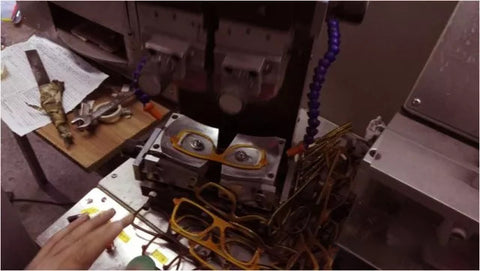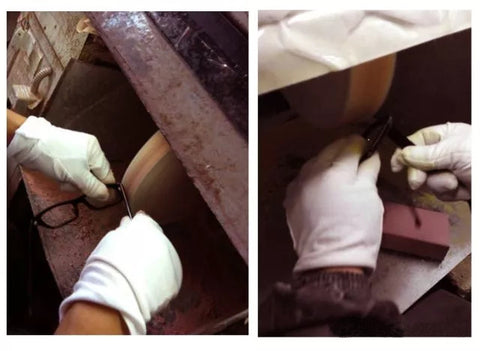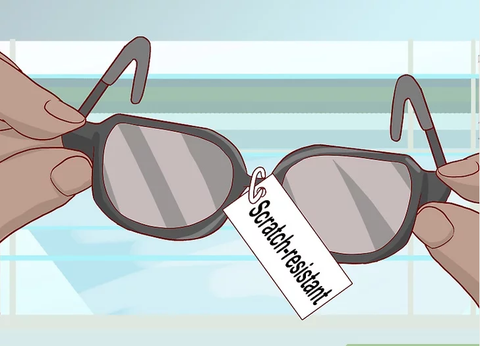news
Sunglasses A-Z
Acetate Material
Acetate—or, more specifically, cellulose acetate—is the caviar of plastics. It’s durable, hypoallergenic, and capable of holding exceptionally rich colors, which makes it an ideal material for eyeglasses and sunglasses.
Anti-reflective coating
All Colossein sunglasses lenses are coated with high-quality super-hydrophobic treatment. This step is especially important for those who work with computers—and it also keeps your glasses looking so fresh ‘n so clean-clean.
Cat-eye Style Frames
Cat-eye frames are a shape of frame that swoop upwards, like…um…cats' eyes. (You saw that coming.)
A woman named Altina Schinasi Miranda is credited with inventing the first cat-eye-like shape in the 1930s. Miranda was a window display designer in Manhattan who thought most glasses were hideous and unsuitable for fashionable ladies. Inspired by harlequin masks she’d seen in Venice, Miranda got creative and designed a pair of glasses that mimicked the masks. (She snipped the first prototypes out of paper). Fast-forward a few years and the new style of glasses is suddenly in vogue AND in Vogue. Marilyn Monroe wore them, Nina Simone wore them, Brigitte Bardot wore them…all the cool girls. Now we call them cat-eye frames. You can wear them even if you’re more of a dog person. It’s allowed.
Fit
Do your frames fit? Here’s how to tell.
- Pupils should be near the center of the lens
- Lenses shouldn’t extend past the side of your face
- Eyebrows should not be inside the glasses
- When you smile, your cheeks shouldn't push the frames up
- Frames shouldn’t slide down your nose
Mixed Material
Some mixed things are bad (like mixed messages). Some mixed things are good (like mixed nuts). Our Mixed Material frames definitely belong to the second category. These frames include densely-hued acetate and metal flourishes.
Nose bridge
“Nose bridge” refers to the slope of the nose in between your eyes. (Put your finger there. It’s a nice little area, isn’t it? Definitely an underrated body part.) A low nose bridge is where the bridge of your nose sits level with or below your pupils. People with low nose bridges often have wide faces and/or high cheekbones. (Tip: Low Bridge Fit frames minimize any pinching and prevent frames from sliding down your nose or resting on your cheeks. Which is fantastic, because no one on earth wants to be pinched by a pair of glasses.)
Nose pads
Twin pads that rest on the sides of your nose and ensure a snug fit.
Polycarbonate
Polycarbonate is an über tough transparent plastic with exceptional impact resistance. (It won’t break if you drop it, unlike eggs, crystal vases, fine china, water balloons, etc.). some of standard Colossein sunglasses and all optical lenses are fashioned from polycarbonate.
Polarized lenses
Polarized lenses eliminate glare, making it easier for you to see without straining your eyes. How do they work? Physics, punk! Light waves vibrate in different directions, and most of the light waves that cause “glare”—those shiny reflections off a pool or a highway—are horizontal. Polarized sunglasses have teensy vertical filters that prevent horizontal light waves from entering. Voilà: no glare. It’s so simple, yet so cool.
Readers
Readers (or reading glasses) are glasses with non-prescription lenses that make it easier to read (or do anything that requires really good eyesight at close range). They’re available in various preset magnification strengths, which users can choose from to match their needs.
Temple
Also known as the arm, this is the part of your glasses that runs alongside your head and holds them in place.
Titanium
Titanium is a strong, durable substance that holds up well under force. (Just like you.) We use it to make glasses because it has a high strength-to-weight ratio, which makes it ideal for an item that rests on your nose. Also: Titanium never rusts.
Its symbol is Ti, like the rapper.
Titanium was discovered in 1791. Other fun things that occurred in 1791: Vermont became a state, the guy who invented Morse code was born, and the world’s first Sunday newspaper was published. Yeah, it was a good year.
Tortoise shell
In the 19th century, tortoise shell was a prized material for all sorts of household objects, from combs to cigar boxes to spoons to paper cutters. Fancy people stored champagne in tortoise shell ice buckets. It made sense: Tortoise shell is a beautiful material, with complex marbled hues and a rich glow. Even the ancient Egyptians used it.
The problem is that tortoise shell originally came from an actual animal; specifically, the hawksbill sea turtle. This big guy grows to three feet long, has a cute little beak, and enjoys swimming among coral reefs and lagoons. In 1973 the Endangered Species Act was passed, which officially protected hawksbill sea turtles from being hunted. They’re still endangered though.
Here’s where it is important to note that our tortoise shell is NOT made from actual tortoises. We would never do that. Instead, ours is made of custom cellulose acetate. Our designers have a lot of fun concocting tortoise hues of every shade—with no cruelty involved.
Yes!
This is what you will shout—possibly accompanied by a fist pump—when you put on your first pair of Colossein sunglasses and glasses. Good times.
Craftsmanship: How the Original Glasses Are Made
Craftsmanship: How the Original Glasses Are Made
When we see a pair of glasses, we tend to think that the simple structure isn’t too complicated to be made. However, just one pair of glasses, from design to production, goes through hundreds of procedures, eventually becoming the elegant masterpiece lying on the bridge of our noses.
Today,
we wanted to introduce
how the original glasses are made.
We are going to skip over the preliminary designing procedures, and mainly introduce the manufacturing procedures of the production processes.
① Plastic Frame
Cutting Ring Materials
Cut the ring material directly into a square. Using the template as a reference, make the cut 4 mm wider, and length 8 mm longer. The bending stake curves the rings, and lengthens it by 6mm.

Plastic Dryer
Put the cut materials into the oven and let dry for 72 hours, furnace temperature controlled at 62-65 degrees Celsius. The cut materials before processing will be shrunk with infrared rays. This is to prevent shrinkage at a later stage.

The Inner Ring, Outer Ring, and Frame Design

The inner ring, outer ring, and frame designs are completed at once by CNC (Computer Numerical Control) and is sent for handcraft.

Restructuring of Ring Materials
After going through rough rolling and mid-rolling, the ring frame material is entered into a small oven to soften, making it easy for restructuring. It must be noted that it cannot be put in the oven for too long, otherwise it would blister.
② Glue
Inserting Pin and Removing Extra Glue
After the pins are put in place, use a cutter blade to remove the glue overflowing on both sides of the hinge by hand, and be very careful not to leave marks on the hinge.
Extra Materials
The glue and eyeglass temples need to be assembled and processed according to their structure or size, and then extra materials are thrown away.

Structuring the Tail
The eyeglass tail is bent at an angle where the curvature and length are based on the drawing requirements.

Levigation
When glue is set with pins, you need to polish with a waterstone to ensure that the surface is smooth without protuberance.

③ Assembly
Peg Hinges
Peg the metal hinge into the front ring. Remember that the hinge can be electroplated but not glued.
Assembly
Align the hinge screws and assemble the front frame with the glue.

Polishing
When the eyeglass frames come out of the roller and assembled, scratches will be naturally made, some parts even with hard spots. Polishing can get rid of these scratches and hard spots, and to the greatest extent boost its shine.

④ Packaging
Lens Cutting
When cutting polaroid and presbyopia lenses, in addition to matching the spectacles to the frame, the parameters also need to be checked if the requirements are correct. As for the plain lenses, it only needs to be matched to the frame.

Labeling
Printed labeling needs to be clear, complete, neat and shouldn’t easily come off.
With the above complex manufacturing processes, can you see why the manufacturers of eyeglasses can be named "craftsmen", and their finished eyeglasses can be treated as works of art?😎
Mido 2018, Fiera Milano Italy, Feb.24-26,2018
Hello Colossein Honey,
COLOSSEIN SUNGLASSES WILL BE Mido 2018, Fiera Milano Italy, Feb.24-26,2018 , Welcome to our Booth, you will find many new sunglasses for hot season in 2018.
Hope Colossein sunglasses can supply you quality service there!
See you in Milano Feb. 2018
http://www.colosseinglasses.com
https://colosseinglasses.com/blogs/news/mido-2018-fiera-milano-italy-feb-24-26-2018
How to pick a sunglasses
- If your idea of shopping for sunglasses is trying on a variety of pairs and glancing at the mirror, these instructions will take it to another whole level. Have you ever thought about UV protection? Durability? Visibility? The shape of your head and face? There's more to sunglasses shopping than looking good!

- 1.Aim to protect your eyes first and foremost. Excessive exposure to UV radiation can cause a variety of problems for your eyes such as cataracts, burns, and cancer.

- 2.If you want your sunglasses to protect you from these risks, look for pairs that block at least 99% of UVB rays and at least 95% of UVA rays. Also look for the amount of cover the sunglasses provide. Look at how much you can see around the frames––will the sunglasses let in sun from the top or sides?
- Are you getting these sunglasses for sports or spending significant time outdoors? Choose ones with a nice close fit, possibly with rubber grips on the arms. If they are for fishing or use on water, polarization is a must; polarized glasses provide more sun protection.

-
3.Don't buy sunglasses if they're labeled as "cosmetic" or don't provide any information on UV protection. Look for scratch resistance, many lenses have very fragile coatings. If you are spending much money, you want them to last. Fortunately damaged lenses can be replaced for most models.

-
1.Select a size. Sunglasses come in all shapes and sizes! Generally, finding a contrast between your face shape and the frame shape will look good. For example, if you have a round face, more angular frames will work well, and if your face is more square, a rounder softer frame shape will look good. Here are a few popular styles:
- Mirrorshades - Mirrored coating on surface. Used a lot by police officers in the US. They usually come in an aviator or wraparound shape.
- Aviators - Teardrop-shaped lens and thin metal frames. Often used by pilots, military personnel, and law enforcement personnel in the US. Good with any face shape, but best with an oval shape.
- Wayfarers/Spicolis - Popular in the 1950s and 1960s. Worn by Audrey Hepburn in the 1961 movie Breakfast at Tiffany's.
- Teashades - Popularized by John Lennon and Ozzy Osbourne. They're not very effective at keeping light out of your eyes, though.
- Wraparounds - Associated with athletics and extreme sports.
- Oversized - Associated with models and movie stars. Glamorous, darling.

- 2.Use the shape of your face to help you pick your sunglasses shape. The following face shape matched to sunglasses style is recommended:
- Oval face: The oval type usually has the "perfect face shape", and can wear any style of glasses. Avoid frames that are either too thick or too thin. Don't choose frames wider than your face width.
- Square face: Because this face shape has very straight, pronounced jawline and edges, choose round glasses to balance out these features. Make sure the frames are not too thick. Try to choose wider sunglasses and avoid rectangular glasses with sharp corners.
- Round face: A round face has plumper cheeks and chin. Choose polygonal or square sunglasses that have an angle design to balance this out. Look for thicker frames.
- Long face: Choose larger lenses and the polygonal frame to modify a long face. Popular retro glasses and sports glasses can be considered.
- Flat face: Choose darker lenses and frames to highlight the contours of the face. Bright colors can also make expressions more vivid!

-
3.Make sure the sunglasses fit properly. Try them on and make sure they don't pinch around your head. The weight should be evenly distributed between your ears and nose, and your eyelashes shouldn't touch the frame or lenses. Glasses should be your stand on the bridge of the nose and ears; if they feel inclined to one side, you need to adjust them. In addition, use the measuring rule that an "eyelash is less than the lens".
Make sure that the lens area is not too small, so that it will be able to block sunlight.
Part 3: Choosing Lens Color Wisely

-
1.Note that the color of the lenses doesn't just affect your fashion statement, it affects how well you detect contrast and differentiate colors. Some colors enhance contrast, which can be useful; however, this is often at the expense of color distinction, which can cause problems (when you're driving, for example, and need to be able to clearly differentiate the colors of a traffic light). Some sunglasses even come with interchangeable lenses so you can change the color easily, depending on what you're doing.
- Gray lenses reduce light intensity without affecting contrast or distorting colors.
- Brown lenses partially enhance contrast by blocking some blue light. Good for snow sports.Also generally good for hunting in bright light, against open backgrounds.
- Amber/yellow lenses significantly enhance contrast because they block most or all blue light, and that makes them popular among hunters who benefit from that contrast when looking at targets against the sky. They're bad, however, for any activity that requires color recognition (like driving!). Good for snow sports.
- Red/orange lenses are good for snow sports but only on overcast days.If you're a hunter, orange lenses are good for clay targets against open backgrounds.
- Violet lenses are good for hunters who need to see clay targets on a green background.
- Copper sunglasses will mute the sky and grass against a golf ball.
- Blue and green sunglasses enhance contrast with a yellow tennis ball.

- 2.Check for distortion. Hold the lenses up to a fluorescent lamp. As you move the sunglasses up and down, check that wave distortion doesn't happen. If it doesn't happen, this is a good sign.

- 1.Choose scratch-resistant lenses. Scratched up sunglasses are useless sunglasses. Lenses made from NXT polyurethane are impact-resistant, flexible, lightweight, and have great optical clarity, but they're expensive.
- Glass is heavier, expensive, and will "spider" if broken.
- Polycarbonate is not as scratch-resistant and provides less optical clarity than NXT polyurethane or glass, but it's more affordable.
- Polyamide is a less used material, which provides glass like optical clarity, without the danger of shattering.
- There are significant differences in scratch resistance of polycarbonate lenses depending on the hardcoat finish applied during construction.
- Acrylic is also affordable, but it's the least durable and optically clear. They are also weak when exposed to heat and often deform. The best choice is glass or resin material
-
https://colosseinglasses.com/blogs/news/how-to-pick-a-sunglasses
http://www.colosseinglasses.com
Please note:This files transfer from wikihow if you hope to read the original files , please go to:https://www.wikihow.com/Pick-Sunglasses












